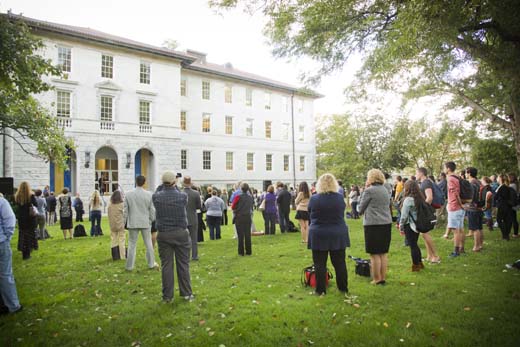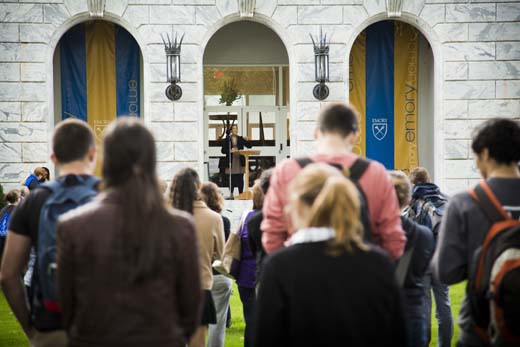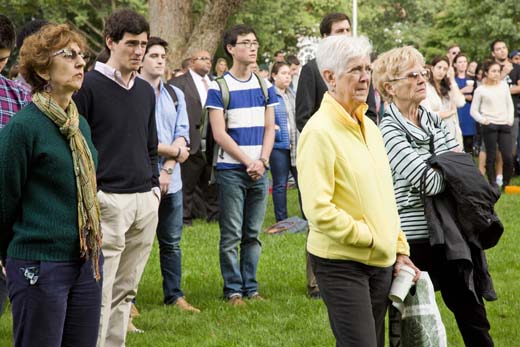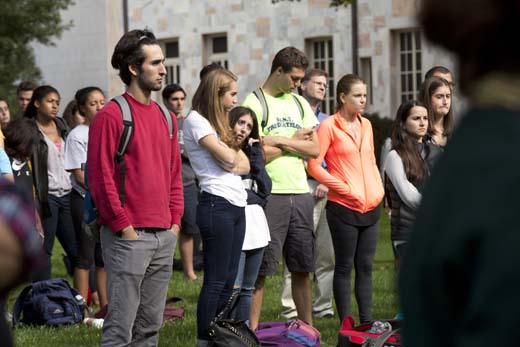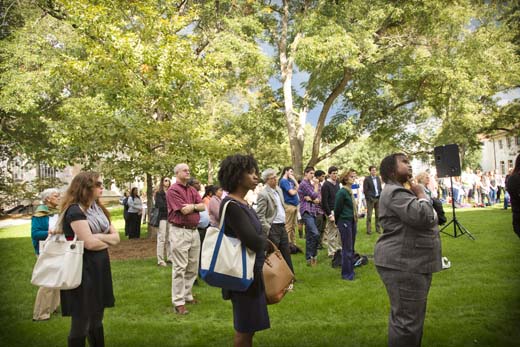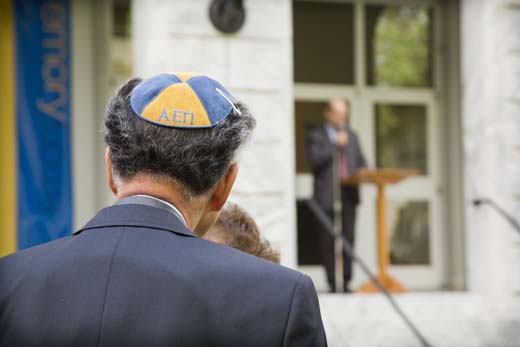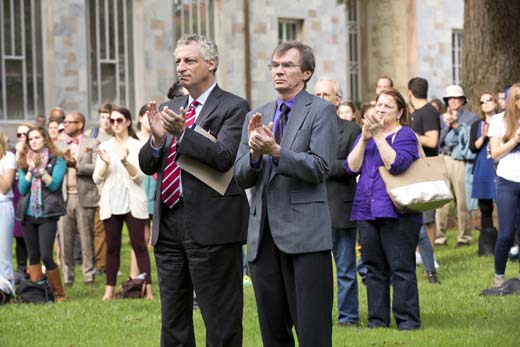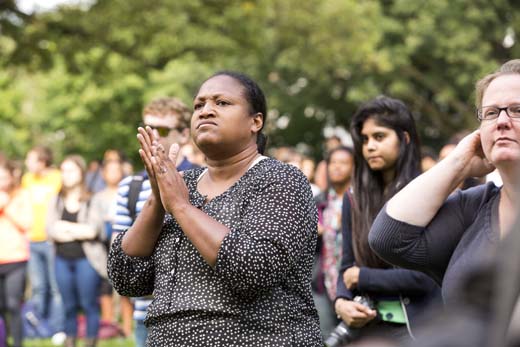The steps of Emory's Administration Building were transformed into an open-air classroom Wednesday, as a crowd of about 200 gathered in dappled fall sunlight to hear Emory faculty share lessons about hate and history, oppression and solidarity.
Sponsored by Emory's Tam Institute for Jewish Studies, with the support of several other campus departments and groups, the public "Teach-In Against Hate" was arranged in response to vandalism at Emory's Alpha Epsilon Pi fraternity, reported Oct. 5 shortly after the end of Yom Kippur.
The incident, now under review by the Federal Bureau of Investigation and Emory Police Department, involved images of swastikas spray painted onto the exterior walls of the historically Jewish fraternity's house.
AEPi President Jack Kuhr opened the forum by recalling the discovery of the graffitti, an act that left members with initial feelings of shock, anger "and most poignantly, a feeling of alienation," Kuhr said.
"This was an act of hate, an attack carried out with intentions of categorizing us, telling us that we were different or unwelcome," he said. "Just as soon as the unity of our community was threatened, Emory grabbed us and yanked us back in, closer than we've ever been before. The support was overwhelming."
Kuhr recounted numerous acts of support directed at the fraternity in the days that followed: a campus-wide letter from President James Wagner condemning the vandalism; sympathetic cards; a note of solidarity from a campus Palestinian advocacy group; free loaves of bread from a local bakery; "and most touchingly, the countless number of people who showed support by giving us a sea of blue on Monday."
"This last week has taught me that Emory's ability to love and take care of each other is truly inspiring," he said.
Although the incident was "horrific," Kuhr noted that he was "grateful it's now given our community a platform to address previously ignored acts of hate and to embark on a new path of a more tolerant Emory."
The afternoon teach-in, attended by President Wagner and a diverse mix of Emory students, faculty and staff, featured comments from four Emory faculty members representing a variety of backgrounds and disciplines. Following are highlights:
Deborah Lipstadt,Dorot Chair, Modern Jewish & Holocaust Studies, Department of Religion
Holding a can of black paint and a paintbrush, Lipstadt observed, "It took these two small items to unite and energize this campus in a way that I haven't seen since I arrived here over 22 years ago."
"But why did we have to wait for something like that to unite and energize us against hate and against obnoxious, scornful symbols directed at a particular group?"
Lipstadt discussed how the Nazi swastika came to represent acts of hatred, oppression and genocide to many people and cultures, including Jews, homosexuals and Roma, known to some as "gypsies."
Seeing swastikas appear on the AEPi house — though incorrectly drawn, Lipstadt noted — carries power. "It may just be a symbol, but hateful acts begin with symbols … and that should be enough to arouse us to action."
Lipstadt said the vandalism left some people asking, "Why all the fuss over one group?" But she cautioned against such comparisons.
"There is no such thing as comparative hate," she said. "Each person's pain is their own … This isn't a competition about who has suffered most. When you hurt, if I am part of your community, I should hurt. I should rally round you … because I recognize that it starts with you, but it never stops with you; it starts with one group, but it never stops with one group."
In responding to the vandalism, Lipstadt praised the campus community "for acting so magnificently" and urged members to "be part of the solution," speaking out against epithets, slurs, bullying and offensive jokes.
To stay silent, she said, is to be "part of the problem."
Andra Gillespie,Interim Chair, Department of African American Studies, and associate professor of political science
At first glance, Gillespie suggested some might wonder why she was present.
"I'm African American and very, very, very Christian," she said. "I was not directly impacted by the swastikas on the AEPi house — or so you think. And that's the reason why I'm here — a hate crime doesn't have to affect me personally for it to affect me."
"You don't' have to be Jewish to recognize that what was done to the AEPi house and to its members was wrong, don't have to be directly impacted by hate to speak out against it," she added.
For some students, this AEPi incident "may be the first time you have experienced oppression in a direct way," Gillespie said.
"Use this experience to walk in the shoes of those who experience that type of discrimination or harassment on a more regular basis," she said. "Be aware of your power. Keep in mind that everybody at some point has power in certain types of situations. And be careful to not use that power to oppress or exploit people."
"Most important, speak up for those who are oppressed — even if they aren't like you," she added.
She urged those interested in helping create change, to seek answers in the classroom.
"This is a teachable moment and we as professors are here to help you in this endeavor," Gillespie said. "We want to help you process this experience, we want to help you put it into proper historical, emotional and psychological context, and we want to provide you with the intellectual tools to be able to help combat this in the future —and to be able to help educate those who don't have the same privileges that you do."
Eric Goldstein, Judith London Evans Director of the Tam Institute for Jewish Studies and associate professor of history and Jewish studies
Gazing upon the Emory Quadrangle, Goldstein offered a history lesson: It was in 1919 — the same year that construction was completed on the Atlanta campus — that the AEPi fraternity established a chapter at Emory. Prior to the move from Oxford, Georgia, to Atlanta, Emory had been populated largely with Protestant students. Coming to Atlanta had brought Jewish students to campus, mostly the sons of recent Jewish immigrants.
At the time, Jews in the U.S. were still struggling to gain "a full part of American life," take advantage of opportunities for education and advancement, and win a measure of social acceptance from their non-Jewish neighbors, said Goldstein, who is also an Emory alumnus.
Historically, acts of anti-Semitism occurred in America "at a time when Jews were succeeding in their attempts to become part of American life," explained Goldstein, who teaches a class in American Jewish history.
Despite such hostilities, Goldstein said history has also shown "there are those who sincerely want to welcome us and engage with us, particularly at Emory."
The same year that an AEPi chapter was founded at Emory, Rabbi Tobias Geffen, a prominent Atlanta rabbi, approached Emory President Warren Candler, a Methodist bishop, about sending his sons to the university, according to Goldstein.
An Orthodox Jew, Geffen was seeking "an excellent secular education that would not force (his sons) to compromise their cherished religious traditions," Goldstein noted.
Not only did Candler assure Geffen that his sons would not be required to turn in schoolwork on Saturday, the Jewish Sabbath, they would also be offered courtesy scholarships, just as he would extend to the sons of Methodist bishops.
Today, the landscape of difference at Emory "is much more rich and complex, in ways that Bishop Candler could have never imagined," Goldstein added.
In a larger sense, the recent acts of vandalism at AEPi "indicate the extent those who perpetrated those acts had to go outside the bounds of socially acceptable behavior in order to register their objections," Goldstein said.
"Thus we should understand and at least find some comfort in the fact that expressions of hate on our campus — as detestable as they may be — reveal that it is the perpetrators, rather than the victims, who are the truly marginal figures," he said. "They stand outside and in opposition to the values of our campus community."
In thinking about hate and how to combat it in our campus and our communities, "we have to remember that while teach-ins and rallies have their place… the most effective way that we can break down barriers of ignorance and discrimination are through small acts of kindness … in our everyday life, our run-of-the mill interactions, where we can reach out to those who are different from us," he said.
The Rev. Bridgette Young Ross, Dean of the Chapel and Spiritual Life
In grappling with the recent vandalism, the Rev. Young Ross found herself returning to a particular word: "Ubuntu."
She first came across the word in "No Future Without Forgiveness," a book by South African Bishop Desmond Tutu that explores recovering from generations of hatred in the post-Apartheid era. It speaks to the concepts of common humanity and connectedness — often described as the glue that held the volatile nation together.
"A person with 'Ubuntu' is open and available to others, affirming of others — would not feel threatened that others are able or good," Young Ross explained. "For he or she has a proper self-assurance of knowing that he or she belongs in a greater whole and is diminished when others are humiliated, or tortured or oppressed or treated as if they are less than who they are."
She noted that it is humbling to remember that the concept rises from a land historically inundated with hatred, bloodshed and violence.
"It is about recognizing that community is more important than revenge — that's a hard lesson for us as human beings," she said. "We forget that people who engage in these things often do not love who they are, they often do not know who they are."
Young Ross recounted how, in a sermon she presented at her recent installation ceremony, she addressed the parable of the Good Samaritan: "We forget the Samaritan is a hated person in that context, a hated person who becomes the greatest example of human good."
"Can you be a good neighbor to someone who has shown hate to you?" she challenged. "Can you be a good neighbor to someone you fear? Who is your neighbor?"
"Our neighbors change from day to day, incident to incident, situation to situation," she said. "We learn by engaging."

